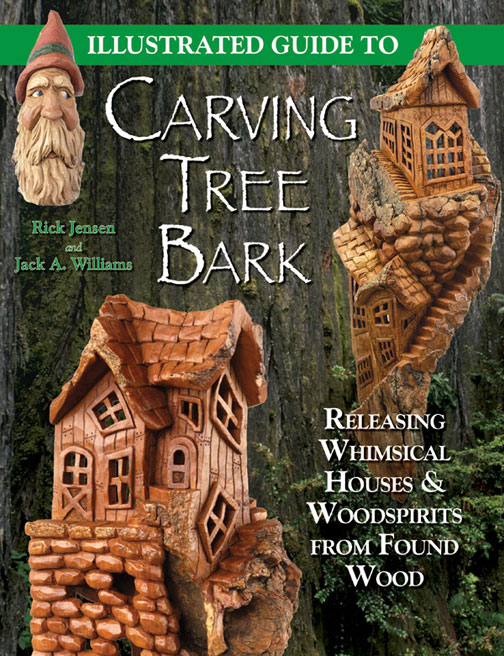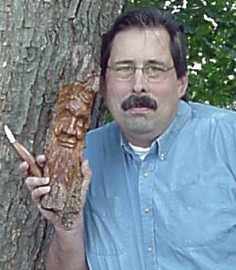

 This
book was a real surprise for me, and
humbling. A lot of the books I purchase these days are because
they're the latest from an author I'm faithful to or they are
a necessity to a complete woodcarving library, or both. Well,
"complete" for my wood carving interests and the classes
I teach that is. If I get one or two new ideas or tips from a
new book it's a bonus and I'm satisfied with the new addition.
I won't justify a bad case of woodcarver's cockiness, but I had
been carving wood spirits for a while, I had carved cottonwood
bark for a while, I had taught both, and I had carved "gnome
homes" before I saw Rick Jensen's wonderful collection of
them in "Carving Found Wood" by Vic Hood and Jack Williams.
This book was not on my hurry-up-and-buy list. That's why I'm
glad Matt came to me wanting a book review because it turned out
to be a real slap in the head for my woodcarving ego.
This
book was a real surprise for me, and
humbling. A lot of the books I purchase these days are because
they're the latest from an author I'm faithful to or they are
a necessity to a complete woodcarving library, or both. Well,
"complete" for my wood carving interests and the classes
I teach that is. If I get one or two new ideas or tips from a
new book it's a bonus and I'm satisfied with the new addition.
I won't justify a bad case of woodcarver's cockiness, but I had
been carving wood spirits for a while, I had carved cottonwood
bark for a while, I had taught both, and I had carved "gnome
homes" before I saw Rick Jensen's wonderful collection of
them in "Carving Found Wood" by Vic Hood and Jack Williams.
This book was not on my hurry-up-and-buy list. That's why I'm
glad Matt came to me wanting a book review because it turned out
to be a real slap in the head for my woodcarving ego.
 "Carving Tree
Bark" by Rick Jensen and Jack A. Williams had more than
a couple new things. It was absolutely stuffed full of new tips
and things related to carving cottonwood bark that I had not seen
or thought of. Like, did you know that Upstate New York cottonwood
bark is wimpier in size because it's a whole separate species
of tree? How about patching holes with putty comprised of ground
up wood bark and glue? I've done it with regular wood, but it
never occurred to me that cottonwood bark could be patched in
the same way. Those of us who love cottonwood bark as a carving
medium know it's easier to carve, but "different". Rick
explains "how" different and illustrates carving techniques
to deal with that subtle difference. Then there's the beauty of
cyanoacrylate glue. That last one I did know. A student of mine
taught me about it when he reattached his wood spirit's nose in
under 30 seconds.. That's only four off the top of my head. Hey!
I'm not going to read the book to you. Call them teasers if you
like.
"Carving Tree
Bark" by Rick Jensen and Jack A. Williams had more than
a couple new things. It was absolutely stuffed full of new tips
and things related to carving cottonwood bark that I had not seen
or thought of. Like, did you know that Upstate New York cottonwood
bark is wimpier in size because it's a whole separate species
of tree? How about patching holes with putty comprised of ground
up wood bark and glue? I've done it with regular wood, but it
never occurred to me that cottonwood bark could be patched in
the same way. Those of us who love cottonwood bark as a carving
medium know it's easier to carve, but "different". Rick
explains "how" different and illustrates carving techniques
to deal with that subtle difference. Then there's the beauty of
cyanoacrylate glue. That last one I did know. A student of mine
taught me about it when he reattached his wood spirit's nose in
under 30 seconds.. That's only four off the top of my head. Hey!
I'm not going to read the book to you. Call them teasers if you
like.
There is another feature of this book that blew me away. It was the photography. Jack Williams' photography is phenomenal with a capital "P". The lighting, angle, subject, and physical pointers are all fantastic. I admired Jack's photography in "Carving Found Wood" also, but the majority of that book is gallery shots. The harder job is a series of well-planned pictures that illustrates a process with the right number of steps, clear, well-lit angles and no gaps in the instruction. This book has much more of that, and Jack's photography contributes so much to the quality of this book that it should always be referred to as Rick Jensen AND Jack Williams' book, "Carving Tree Bark". That is no exaggeration. In fact, I would love to see Jack Williams do a solo book "Photographing Your Woodcarvings/Artwork"
Now for a chapter-by-chapter tour (with highlights):
About the Authors
A "good read" area
Why I Carve Bark
Another "good read" area
Gallery of Bark Carvings
Eye candy to inspire even the veteran
bark carvers
1: About Cottonwood Bark
The different cottonwood species, harvesting,
and storage
2: Bark Carving Basics
Among other neat stuff, how to deal
with the "difference" about carving bark
3: Carving a Whimsical House
This is your first step-by-step project
area. Bookmark page 30-31 for great tips on collecting architectural
textures and suggestions for doors and windows
4: Carving Tree Bark in the Round
This is the only chapter that made
me wince. Probably because you remove all evidence that the carving
material used to be tree bark
5: Finishing Bark Carvings
Lacquer, clear wax, shoe polish, and
paint. A great table on all the various "Santa reds"
there are. Some things you can bet I'm going to try
6: Patterns
All wood spirit type patterns and a
great paragraph on "The Legend of the Wood Spirit.
Appendix: Sources for Cottonwood Bark
My favorite source isn't here, but
considering all the new bark carvers this book should generate,
that might be a good thing.
OK Matt, there's no perfect
woodcarving book yet, but in regards
to the subject matter this one was written for, I think it is
worthy of a 4  and half thumb rating.
The only reason this
book should not be in your library is if you are deathly allergic
to cottonwood bark. Well Gang,
keep them edges keen, the chips piled high, and remember no one
knows as much as everyone.
and half thumb rating.
The only reason this
book should not be in your library is if you are deathly allergic
to cottonwood bark. Well Gang,
keep them edges keen, the chips piled high, and remember no one
knows as much as everyone.
 Mike Bloomquist is a carver
and carving teacher, and a frequent contributor to WOM.
Mike Bloomquist is a carver
and carving teacher, and a frequent contributor to WOM.
You may visit Mike's web site, Wooden Dreams Woodcarving HERE or email him at m.bloomquistATverizonDOTnet.